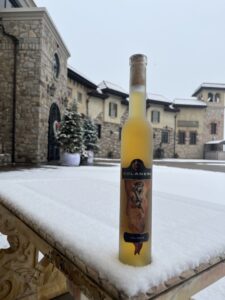Sugar is an essential element that plays a critical role in shaping a wine’s character. Whether you prefer your wine very dry or decadently sweet, sugar influences everything from the wine’s taste and texture to its alcohol content. In this blog, we’ll explore the role of sugar in wine, how it affects flavour, and why it matters in both winemaking and wine tasting.
The Role of Sugar in Wine
Sugar in wine primarily comes from the grapes themselves. Grapes contain natural sugars, mainly glucose and fructose, which are fermented by yeast during the winemaking process. As yeast consumes these sugars, it produces alcohol and carbon dioxide (among other side products). This conversion of sugar to alcohol is what transforms grape juice into wine. However, not all of the sugar is always fully fermented, and the amount of sugar left in the wine after fermentation is called “residual sugar”.
Residual sugar, or RS, refers to the unfermented sugars that remain in the wine. It can influence the wine’s sweetness level and style. In general, wines with less than 10 grams per liter of RS are considered dry, while wines with higher amounts of RS are classified as off-dry, semi-sweet, or sweet.
The Impact of Sugar on Wine Styles
The amount of sugar left in wine defines its sweetness and wines can be categorized into several different sweetness levels:
1. Dry Wines
Dry wines contain very low levels of residual sugar (less than 10 g/L). These wines taste crisp, clean, and refreshing, often with prominent acidity. Classic examples include Sauvignon Blanc, Chardonnay, and Cabernet Sauvignon. Despite the perception that dry wines have no sugar, there is always a tiny amount left, but it is generally undetectable to taste.
2. Off-Dry Wines
Off-dry wines have a slight sweetness, with RS levels around 10 to 19 g/L. The subtle sweetness in these wines is often balanced by acidity, creating a pleasant, refreshing wine with just a hint of sugar. Popular off-dry wines include Riesling and certain styles of Pinot Grigio.
3. Semi-Sweet Wines
With RS levels typically between 20 and 39 g/L, semi-sweet wines are noticeably sweet but not overpowering. These wines are often enjoyed as dessert wines, but they can also complement spicy  cuisine. Moscato and some Zinfandels fit into this category.
cuisine. Moscato and some Zinfandels fit into this category.
4. Sweet Wines
Sweet wines, like Port, Sauternes, and Icewine, contain significant amounts of residual sugar, often more than 45 g/L. These wines are lush, syrupy, and perfect for pairing with desserts or enjoying on their own as a sweet treat. Icewines are anywhere between 150 and 290 g/L!
Sugar’s Role in Alcohol Production
The relationship between sugar and alcohol in wine is key to understanding how a wine’s characteristics develop. As yeast consumes sugar, it creates alcohol. Therefore, the more sugar present at the start of fermentation, the higher the potential alcohol content. In warmer climates, grapes accumulate more sugar, leading to wines with higher alcohol levels. Conversely, cooler climates may produce grapes with lower sugar levels, resulting in wines with lower alcohol content.
However, winemakers have control over this process. They can stop fermentation early to retain some of the natural grape sugars, resulting in wines with lower alcohol but higher residual sugar. This technique is often used to create sweeter styles or certain types of dessert wines.
The Balance Between Acidity & Sweetness
Sugar must be balanced with other elements, particularly acidity or alcohol, to create a harmonious wine. Acidity provides structure and freshness, acting as a counterbalance to sweetness. A wine with high residual sugar but low acidity may taste overly sweet. On the other hand, a wine with both high sweetness and high acidity can taste balanced and vibrant.
This balance is essential for wines at all sweetness levels. Even dry wines benefit from having a touch of residual sugar to soften their sharp acidity. For example, in some sparkling wines like Champagne, a small amount of sugar is added after secondary fermentation to balance the wine’s high acidity, resulting in a smoother, more rounded flavour.
Can Decanting Impact the Sweetness of Wine?
Decanting can affect the perception of sweetness and other flavours by allowing the wine to breathe. The exposure to oxygen can help to soften tannins and enhance aromas, which might make a wine with residual sugar taste more balanced or less intense – but the actual sugar level remains the same. Decanting mainly benefits wines with strong tannins, sediment, or complex aromas that need aeration to open up, rather than altering elements like sugar.
Sugar & Wine Pairing
Sugar also plays an important role in wine pairing. Sweet wines can be a delightful match with a variety of foods. The key to successful pairings is understanding the balance between sweetness and other flavours in the dish.
Sweet Wines with Spicy Food: The slight sweetness in wines like off-dry Riesling or Gewürztraminer can help tame the heat of spicy dishes, creating a cooling effect on the palate.

Sweet Wines with Savoury Food: In some cases, sweet wines can complement rich, salty foods, such as pairing Sauternes with foie gras or blue cheese. The contrast between the sweet wine and the savory dish creates a memorable taste experience.
Sweet Wines with Dessert: Naturally, sweet wines are a classic choice for dessert pairing. Typically, the wine should be as sweet, if not sweeter, than the dessert. For example, a rich, honeyed ice wine pairs beautifully with a fruit tart or crème brûlée.
To explore food pairings for Colaneri Estate wines, browse our wine colletion here and click on individual bottles for our recommendations.
Sugar plays a crucial role in wine, affecting not only its sweetness but also its alcohol content, texture, and balance. Whether you enjoy dry wines or prefer sweeter varieties, sugar is an essential element that contributes to the magic in every bottle.


